

Princess and monster game. This game remained a well-known open problem until it was solved by Shmuel Gal in the late 1970s.[2][3] His optimal strategy for the princess is to move to a random location in the room and stay still for a time interval which is not too short but not too long, before going to another (independent) random location and repeating the procedure.[3][4][5] The proposed optimal search strategy, for the monster, is based on subdividing the room into many narrow rectangles, picking a rectangle at random and searching it in some specific way, after some time picking another rectangle randomly and independently, and so on.
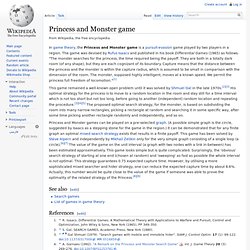
See also[edit] References[edit] Jump up ^ R. Isaacs, Differential Games: A Mathematical Theory with Applications to Warfare and Pursuit, Control and Optimization, John Wiley & Sons, New York (1965), PP 349–350.Jump up ^ S. Gal, SEARCH GAMES, Academic Press, New York (1980).^ Jump up to: a b Gal Shmuel (1979). Homicidal chauffeur problem. In game theory, the homicidal chauffeur problem is a mathematical pursuit problem which pits a hypothetical runner, who can only move slowly, but is highly maneuverable, against the driver of a motor vehicle, which is much faster but far less maneuverable, who is attempting to run him down.
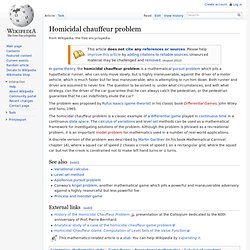
Both runner and driver are assumed to never tire. The question to be solved is: under what circumstances, and with what strategy, can the driver of the car guarantee that he can always catch the pedestrian, or the pedestrian guarantee that he can indefinitely elude the car? Angel problem. The blue dotted region shows where an angel of power 3 could reach The angel problem is: can an angel with high enough power win?
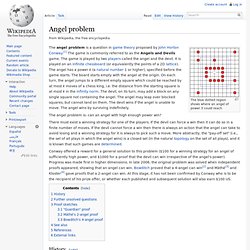
There must exist a winning strategy for one of the players. If the devil can force a win then it can do so in a finite number of moves. If the devil cannot force a win then there is always an action that the angel can take to avoid losing and a winning strategy for it is always to pick such a move. More abstractly, the "pay-off set" (i.e., the set of all plays in which the angel wins) is a closed set (in the natural topology on the set of all plays), and it is known that such games are determined. Conway offered a reward for a general solution to this problem ($100 for a winning strategy for an angel of sufficiently high power, and $1000 for a proof that the devil can win irrespective of the angel's power).
History[edit] If the angel has power 1, the devil has a winning strategy (Conway, 1982). In three dimensions, it was shown that: Proof sketches[edit] where and. Path decomposition. In graph theory, a path decomposition of a graph G is, informally, a representation of G as a "thickened" path graph,[1] and the pathwidth of G is a number that measures how much the path was thickened to form G.
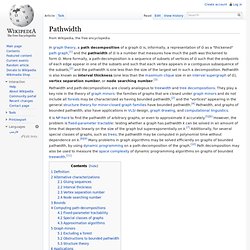
More formally, a path-decomposition is a sequence of subsets of vertices of G such that the endpoints of each edge appear in one of the subsets and such that each vertex appears in a contiguous subsequence of the subsets,[2] and the pathwidth is one less than the size of the largest set in such a decomposition. Pathwidth is also known as interval thickness (one less than the maximum clique size in an interval supergraph of G), vertex separation number, or node searching number.[3] Definition[edit] For each edge of G, there exists an i such that both endpoints of the edge belong to subset Xi, andFor every three indices i ≤ j ≤ k, Xi ∩ Xk ⊆ Xj.
Alternative characterizations[edit] As Bodlaender (1998) describes, pathwidth can be characterized in many equivalent ways. Bounds[edit] Tree decomposition. Treewidth is commonly used as a parameter in the parameterized complexity analysis of graph algorithms.
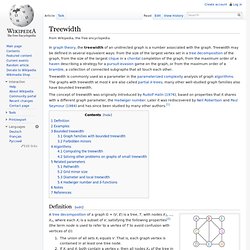
The graphs with treewidth at most k are also called partial k-trees; many other well-studied graph families also have bounded treewidth. Definition[edit] A graph with eight vertices, and a tree decomposition of it onto a tree with six nodes. Each graph edge connects two vertices that are listed together at some tree node, and each graph vertex is listed at the nodes of a contiguous subtree of the tree. Each tree node lists at most three vertices, so the width of this decomposition is two.